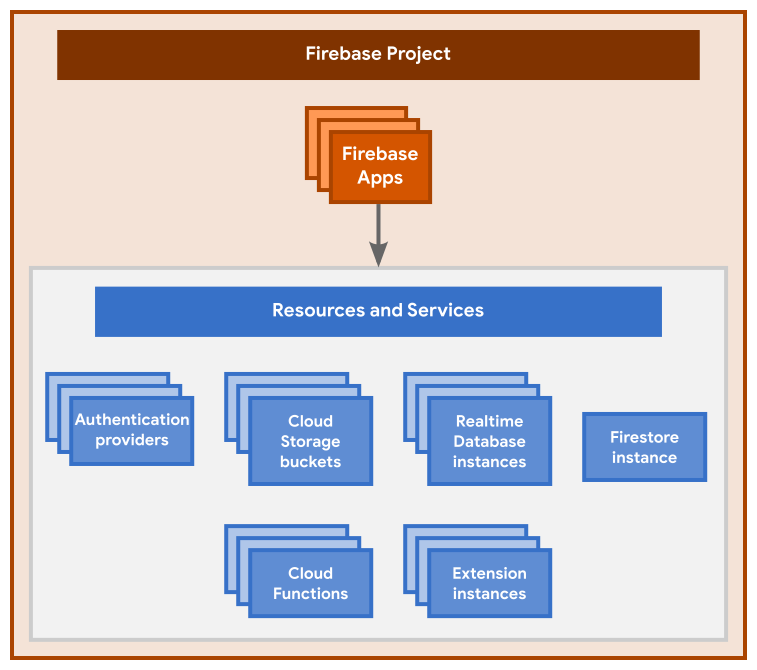Auf dieser Seite finden Sie allgemeine Best Practices für die Einrichtung von Firebase-Projekten und die Registrierung Ihrer Apps bei einem Projekt. So haben Sie einen klaren Entwicklungsablauf mit verschiedenen Umgebungen. Wenn Sie mit den Best Practices auf dieser Seite vertraut sind, lesen Sie unsere allgemeinen Sicherheitsrichtlinien.
Hierarchie von Firebase-Projekten
 Dieses Diagramm zeigt die grundlegende Hierarchie eines Firebase-Projekts. Hier sind die wichtigsten Beziehungen:
Dieses Diagramm zeigt die grundlegende Hierarchie eines Firebase-Projekts. Hier sind die wichtigsten Beziehungen:
Ein Firebase-Projekt ist wie ein Container für alle Ihre Apps und alle für das Projekt bereitgestellten Ressourcen und Dienste.
Bei einem Firebase-Projekt können eine oder mehrere Firebase-Apps registriert sein, z. B. sowohl die iOS- als auch die Android-Version einer App oder sowohl die kostenlose als auch die kostenpflichtige Version einer App.
Alle Firebase-Apps, die für dasselbe Firebase-Projekt registriert sind, teilen sich die für das Projekt bereitgestellten Ressourcen und Dienste und haben Zugriff darauf. Hier sind einige Beispiele:
Alle Firebase-Apps, die für dasselbe Firebase-Projekt registriert sind, verwenden dieselben Backends, z. B. Firebase Hosting, Authentication, Realtime Database, Cloud Firestore, Cloud Storage und Cloud Functions.
Alle Firebase-Apps, die mit demselben Firebase-Projekt registriert sind, sind mit derselben Google Analytics-Property verknüpft. Dabei ist jede Firebase-App ein separater Datenstream in dieser Property.
Wo passt ein Google Cloud-Projekt in diese Hierarchie?
Ein Aspekt der Firebase-Projekthierarchie, der im Diagramm oben nicht dargestellt ist, ist die Beziehung zu einem Google Cloud-Projekt. Ein Firebase-Projekt ist im Grunde nur ein Google Cloud-Projekt, für das zusätzliche Firebase-spezifische Konfigurationen und Dienste aktiviert sind. Alle Apps, die für dasselbe Firebase-Projekt registriert sind, teilen sich dieselben Google Cloud-Ressourcen und ‐Dienste und haben darauf Zugriff.
Weitere Informationen zur Beziehung zwischen Firebase und Google Cloud finden Sie unter Firebase-Projekte kennenlernen.
App-Varianten in Firebase-Projekten registrieren
Hier sind einige wichtige Tipps zur Registrierung Ihrer App-Varianten in einem Firebase-Projekt:
Alle in einem Firebase-Projekt registrierten Apps müssen aus Sicht der Endnutzer Plattformvarianten derselben Anwendung sein. Registrieren Sie die iOS-, Android- und Webversionen derselben App oder desselben Spiels im selben Firebase-Projekt.
Wenn Sie mehrere Buildvarianten haben, die dieselben Firebase-Ressourcen verwenden könnten, registrieren Sie die Varianten im selben Firebase-Projekt. Beispiele hierfür sind ein Blog und eine Webanwendung im selben Projekt oder die kostenlose und die kostenpflichtige Version derselben App im selben Projekt.
Wenn Sie mehrere Buildvarianten haben, die auf dem Release-Status basieren (nicht auf allgemeinen Endnutzeraktivitäten oder Zugriffen wie oben), registrieren Sie jede Variante in einem separaten Firebase-Projekt. Ein Beispiel sind Debug- und Release-Builds. Registrieren Sie jeden dieser Builds in einem eigenen Firebase-Projekt.
Builds, die auf dem Release-Status basieren, sollten nicht dieselben Firebase-Ressourcen verwenden, da dies das Risiko birgt, dass Ihre Debug-Daten Ihre Produktionsdaten verunreinigen oder sogar überschreiben.
Die Plattform-Varianten jeder dieser Build-Varianten sollten sich im gleichen Firebase-Projekt befinden. Sie können beispielsweise sowohl die iOS- als auch die Android-Debug-Builds in einem Firebase-Entwicklerprojekt registrieren, da beide mit denselben nicht produktionsbezogenen Daten und Ressourcen interagieren können.
Mehrinstanzenfähigkeit vermeiden
Die Mehrfachnutzung kann zu ernsthaften Problemen bei der Konfiguration und dem Datenschutz führen, einschließlich unbeabsichtigter Probleme bei der Analyseaggregation, der gemeinsamen Authentifizierung, übermäßig komplexer Datenbankstrukturen und Schwierigkeiten mit Sicherheitsregeln.
Wenn mehrere Apps nicht dieselben Daten und Konfigurationen verwenden, sollten Sie jede App in einem separaten Firebase-Projekt registrieren.
Wenn Sie beispielsweise eine White-Label-Anwendung entwickeln, sollte jede unabhängig gekennzeichnete App ein eigenes Firebase-Projekt haben. Die iOS- und Android-Versionen dieses Labels sollten sich im selben Firebase-Projekt befinden. Jede unabhängig gekennzeichnete App darf aus Datenschutzgründen keine Daten mit anderen Apps teilen.
Nächste Schritte
Lesen Sie die allgemeinen Sicherheitsrichtlinien für verschiedene Umgebungen. Sie möchten dafür sorgen, dass jede Umgebung und ihre Daten sicher sind.
Sehen Sie sich die Checkliste für die Einführung von Firebase an.

